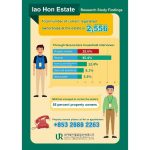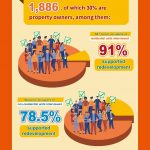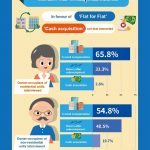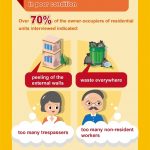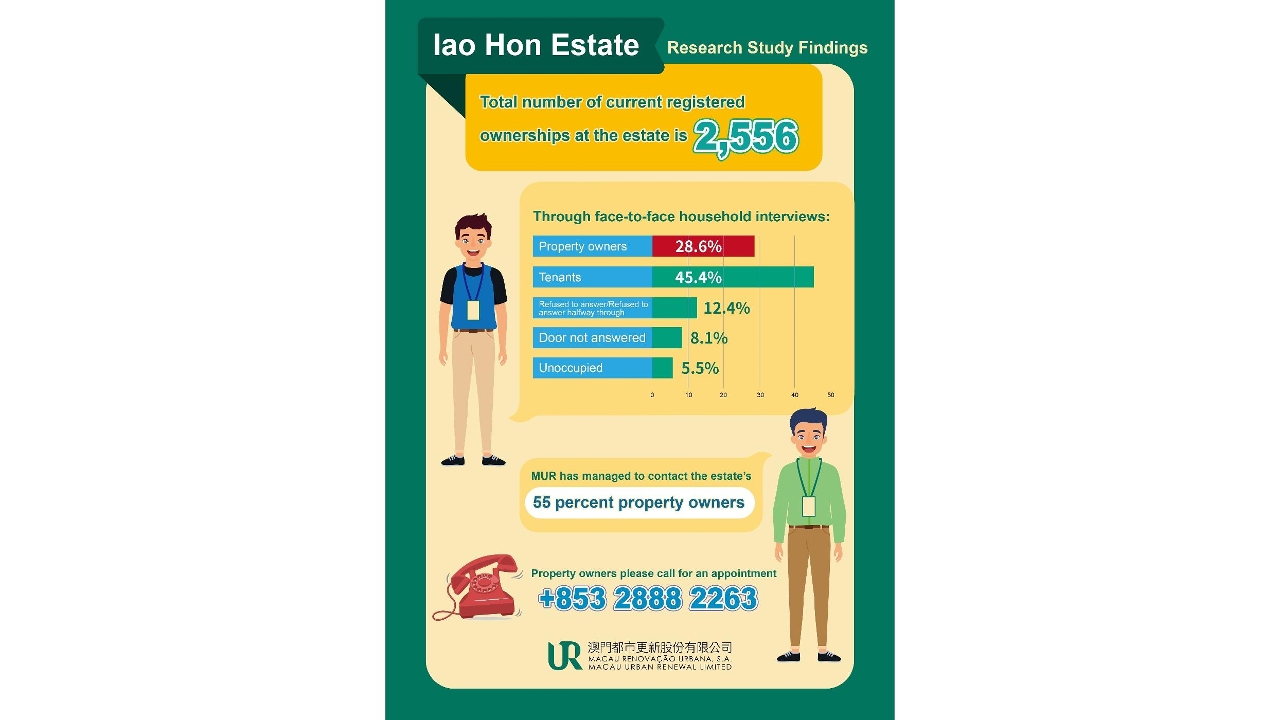
A survey conducted recently finds that about 30 percent of the flats in Iao Hon Estate were owner-occupied units and about 45 percent tenant-occupied, the rest were either unoccupied or where no one answered the door.
The survey shows that over 90 percent of owner-occupiers of residential units interviewed supported the redevelopment of Iao Hon Estate, while a small number of owner-occupiers of non-residential units interviewed did not support redevelopment or did not provide a clear answer, taking a wait-and-see attitude toward the matter.
Macau Urban Renewal Limited (MUR) is promoting the estate’s redevelopment work under the legal framework. Currently, the company has been in contact with over 55 percent of Iao Hon Estate’s property owners. However, the key to redevelopment is that property owners need to reach a consensus, therefore MUR urges property owners to contact the company as soon as they can.
To understand the disposition of the estate’s residential and non-residential units, the vacancy rate, property owners’ and tenants’ views and expectations on redevelopment, the distribution of owners and also to collect their contact details, MUR assigned Root Planning Cooperative last year to conduct face-to-face household interviews as part of a research study on Iao Hon Estate to have a grasp on the current condition of those aspects and advance redevelopment work.
The research study covered all 2,556 residential and non-residential units at Iao Hon Estate, which includes seven blocks: Hong Tai House, Kat Cheong House, Son Lei House, Heng Long House, Mau Tan House, Man Sau House and Seng Yee House.
The research study comprised of household questionnaire interviews and a survey on the flat’s current situation. Fully completed questionnaires totalled 1,886, accounting for 73.8 percent of the total number of current registered ownerships at the estate. The rest were incomplete because respondents refused to answer halfway through (0.9 percent), refused to answer the questionnaire (11.7 percent), no one answered the door (8.1 percent), and because they were unoccupied flats (5.5 percent). For matters that are not fully reflected in the survey but are related to the study, they were documented using photos and illustrations for analysis.
55 percent property owners contacted
Residents at the estate were mostly tenants. The findings show that of the 1,886 respondents, 731 were owner-occupiers of residential units (674) and owner-occupiers or their representatives of non-residential units (84), representing 28.6 percent of the current total 2,556 registered ownerships. Among the owner-occupiers or their representatives, over 50 percent were people aged 60 or above. Tenants (including locals and non-resident workers) accounted for 45.4 percent. Refusal to answer the questionnaire, refusal to answer halfway through, no one answering the door and unoccupied flats accounted for 26 percent.
Based on the research study and through different channels and methods, MUR has contacted about 55 percent of the estate’s property owners. MUR will make every effort to keep looking for the remaining property owners, while urges related property owners to contact the company so that redevelopment can quickly begin.
The findings show that the estate had a total of 2,780 units, the SAR Government demolished buildings D, E, F and G of Son Lei House in 2009 which comprised 224 units, therefore the estate now contains a total of 2,556 units. Among the 2,556 units, 2,428 were residential and 128 were non-residential. These non-residential units were registered as commercial units and industrial units, among others, and based on the survey of the current condition of the units, a majority of them were used for business activities. Moreover, it is found in the survey that a significant number of residential units were being used for business activities or non-residential purposes, including 106 residential units.
Average 5.3 persons living in one flat
Iao Hon has quite a high population density, one of the reasons being that a large number of non-resident workers live there.
Based on the findings of the study, it is estimated that about 12,014 people are living in Iao Hon Estate, and that 2,316 units are actually used for residential purpose. Considering that the average vacancy rate in Macau is 7.3 percent, it is estimated that 2,147 units had people living in there, with an average of 5.3 persons per unit, much higher than the average of about three persons per unit in Macau.
The findings show that about 30 percent of the estate’s units were used as staff accommodation for non-resident workers, and a majority of these units had seven or more people living in there.
Residential unit owners mostly support redevelopment, some non-residential unit owners wait and see
On supporting the redevelopment of the estate, 91.03 percent of the 647 owner-occupiers of residential units interviewed supported redevelopment, with 8.97 percent saying they don’t support, they have no comment, they don’t know or refuse to answer. Meanwhile, 78.5 percent of the 84 owner-occupiers of non-residential units interviewed supported redevelopment, with 21.5 percent saying they don’t support or not giving a clear answer. This shows that some of the owner-occupiers of non-residential units have a wait-and-see approach on redevelopment.
In favour of ‘flat for flat’, not that interested in ‘cash acquisition’
In an open-ended question regarding compensation during redevelopment, respondents were asked to suggest a form of compensation that they find acceptable. The answers show that 65.8 percent of owner-occupiers of residential units would accept in-kind compensation with ‘advance viewing of an existing property that it is not public housing property’; while 32.3 percent suggested ‘returning to their original property after redevelopment’. Only 2.6 percent of the respondents suggested ‘property acquisition in cash’, indicating little interest in cash compensation.
Owner-occupiers of non-residential units interviewed prefer returning to their original properties more than owner-occupiers of residential units. They were more in favour of being compensated with a shop unit which they call ‘shop for shop’ (54.8 percent) or ‘returning to their original shop unit after redevelopment’ (40.5 percent).
In addition, Iao Hon is in a poor condition. Over 70 percent of the owner-occupiers of residential units interviewed reported ‘peeling of the external walls’ (75.6 percent), ‘waste everywhere’ (73.3 percent), ‘too many trespassers’ (71.1 percent) and ‘too many non-resident workers’ (71.1 percent). Almost 80 percent of owner occupiers of residential units interviewed said they hoped there will be community facilities such as parks, wet markets, supermarkets, bus stops and banks in the area after redevelopment.
Complicated property ownership issues
Property ownership is one of the critical factors that determines the progress of redevelopment. The survey finds that only 3.4 percent of owner-occupiers of residential units interviewed and 3.6 percent of owner-occupiers of non-residential units interviewed acknowledged that there are ownership issues at their property.
However, among the 55 percent of property owners that MUR has been in contact with, the company has already found that about 5 percent of them have property ownership issues.
An analysis on the difference between the two sets of figures reflects that respondents’ legal awareness, family status and inheritance distribution are some of the aspects involved in their property ownership issues. The main reasons for this difference include:
- Respondents might not be fully aware that there are property ownership issues at the flats they are living in, and issues are usually about inheritance distribution, matrimonial property regime and divorce, among others;
- Respondents were reluctant to talk about or address the issues due to privacy considerations.
A comprehensive analysis of the survey results shows that redeveloping Iao Hon Estate is challenging, especially with issues related to property ownership and the requirement of owners to reach a consensus.
According to the data collected, the number of property owners that could be contacted at each block varies considerably. While MUR has managed to contact 70 percent of the property owners at some blocks, the company has so far only managed to contact 40 percent of the property owners at others.
To speed up the redevelopment process, MUR will be adopting a block-by-block approach. Based on the progress of collecting property owners’ consent, the first block to have all property owners’ consent would have priority to redevelopment.
In addition to household interviews and analysis, the research team has also provided several suggestions in the report, including:
- Continuously follow up on the community’s situation;
- Need for clearer policies and laws for redevelopment to advance;
- Provide legal assistance for property owners;
- Provide a variety of compensation plans that meet residents’ needs;
- Grasp on current status and usage of the units to be used as considerations to devise compensation plans;
- Continue monitoring the buildings’ structure.
Property owners, please contact MUR
MUR will take these views and suggestions as reference and in accordance with the actual situation, the company will actively carry out the work. At this stage, MUR will continue to promote redevelopment based on the legal framework with these suggestions in mind. This includes coordinating with relevant entities on consultation and legislation, submitting the report and views to relevant entities for their reference. MUR will continue to contact the estate’s property owners through different channels to get a better understanding of their views on redevelopment and to identify ownership issues so that the company could help provide legal consultations in preparation for redevelopment.
Through promotion campaigns and neighbourhood network, MUR has so far contacted over 55 percent of the property owners and will make every effort to get in contact with the remaining 45 percent of property owners.
As an executing entity promoting urban renewal in Macau, MUR will continuously follow up on the redevelopment of the Iao Hon community, use different ways to find the remaining property owners, and quickly resolve issues such as ownership problems. MUR will promote urban renewal progress in accordance with the law, based on relevant urban renewal regulations and overall planning policies.
For more information on the research study’s report, please visit MUR’s official website https://www.mur.com.mo. Iao Hon Estate’s property owners please call 2888 2263 to make an appointment with MUR to discuss redevelopment.


